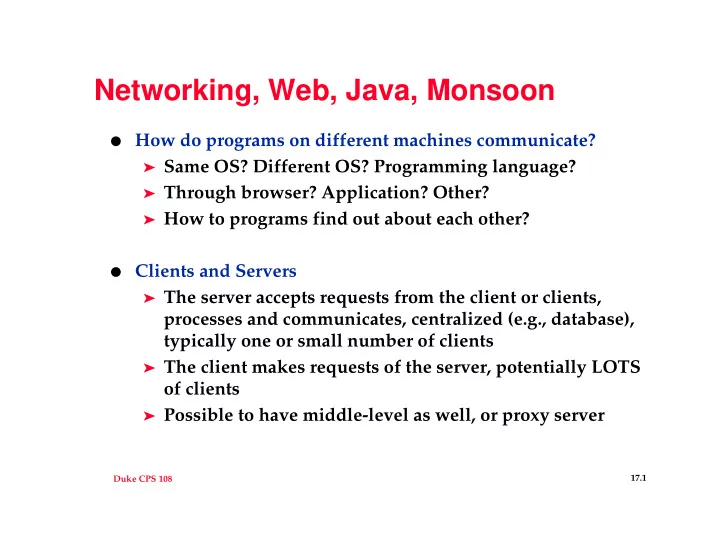

Networking, Web, Java, Monsoon ● How do programs on different machines communicate? ➤ Same OS? Different OS? Programming language? ➤ Through browser? Application? Other? ➤ How to programs find out about each other? ● Clients and Servers ➤ The server accepts requests from the client or clients, processes and communicates, centralized (e.g., database), typically one or small number of clients ➤ The client makes requests of the server, potentially LOTS of clients ➤ Possible to have middle-level as well, or proxy server 17.1 Duke CPS 108
Low-level communication ● A socket is a two-way pipe that can be opened between programs ➤ Low-level communication, basically byte-at-a-time ➤ Possible to send strings as formatted byte sequence ● Protocol must be explicit between client and server, and protocol is low-level ➤ If string read is this, do that ➤ Expect a string, process it ● Socket uses host address and port number, agreed on by client and server ➤ In Java it’s easy to create a socket, get reader/writer ➤ Can do this in C/C++, write a class to re-use ● See Client.java and Server.java example 17.2 Duke CPS 108
Other methods of communication ● Applet – client side program that can talk to server ➤ Applet is Java code downloaded over the web, run in JVM that’s part of browser on the client side ➤ Applet cannot (by default) communicate with client computer, but can communicate back to host/server ➤ Advantages of applets? Drawbacks? ● RMI – remote method invocation ➤ Objects on different machines communicate directly by method calls between objects, just like “regular” programs ➤ Java takes care of turning method calls/parameters into low-level bytes as needed ➤ Client/Server roles mixed, calls go each way ➤ Need lots of infrastructure, Java supplies most of it 17.3 Duke CPS 108
Web architectures for client/server ● CGI: Common Gateway Interface ➤ Web server communicates with CGI programs ➤ CGI programs written in any language, web server mediates between the CGI server program and the browser/client ● Typically each CGI request starts a new process ➤ Process is heavyweight (compared to thread), doesn’t scale ➤ FastCGI: shares CGI programs (don’t restart, reuse?), mod_perl , execute CGI scripts/programs in web server ● ASP: Active Server Pages ➤ Combines HTML, scripts, server-side programs (COM) ➤ For practical purposes limited to Windows web servers 17.4 Duke CPS 108
Servlets ● Java program that takes HTTP requests, processes them, returns HTTP result ➤ Executes as server-side program, similar to CGI ➤ Doesn’t start new process, executes within JVM as a thread ➤ Benefits from Java security model within JVM ➤ Portable (in theory) to many platforms ➤ In some ways like a server-side applet ● Many libraries available as part of Java and via third parties for extending functionality of Servlets ➤ Need servlet engine that interfaces with Web server ➤ In fourth quarter 99, Apache web server has 60% of market, has Servlet engine as an add on 17.5 Duke CPS 108
Recommend
More recommend